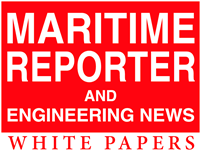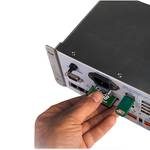
Even the smallest hydraulic system failure can be very costly in terms of lost productivity, change-out times and repairs. This is compounded in large-scale operations, such as oil rigs or dredging sites. When a hydraulic system failure occurs, it is commonly blamed on the oil or hydraulic fluid being used, and rightly so, since it is estimated that 90 percent of the time a fluid-related pump failure is due to contamination. However, rather than simply questioning the quality or performance of the fluid itself, it is important to examine HOW the contamination occurred, what might have been done to prevent it, and to use this information to mitigate potential future problems. According to original equipment manufacturers and tribologists, the number one cause of hydraulic system failure is water contamination. Through a series of chemical reactions, the presence of water in the system builds a corrosive environment, which shortens the life of the pump or other equipment. While it is impossible to prevent water from getting into your system, there is a series of procedures and protocols that maintenance professionals can implement to measure the amount of water in the system and work to remove it before a failure occurs.
Even under the best circumstances and most controlled environments, it is virtually impossible to prevent water from entering a hydraulic system. Water can seep in through external sources (through cylinders or leaky seals, leaking into external reservoirs and even through rain or routine washdowns). Water can also come from internal sources, including condensation and heat exchangers. For example, a system run in hot, humid environments takes in air containing water vapor, which condenses as it cools and remains in the hydraulic system.
This water can be present as dissolved, emulsified or free water. The point at which the fluid cannot hold any more dissolved water is called saturation. Hydraulic fluid saturation points vary based on the fluid base oil and the additives used, as well as operating conditions, including pressure and temperature.
One of the tell-tale signs of oversaturated fluid is cloudiness. However, in a closed system, the level of water in the system can be difficult to detect until there are problems.
Long before a failure, the following problems begin to occur when the saturation point is reached:
The type of oil or fluid used can have a major impact on water contamination and removing water from a system. Where traditional oil-based lubricants can be used on land applications, the United States Environmental Protection Agency’s Vessel General Permit regulations require the use of environmentally acceptable lubricants (EALs) in marine environments. However, traditional oils and different classes of EALs react differently with water. Unlike traditional oils, which do not mix with water, some EALs, including certain hydraulic environmental synthetic esters (HEESs) and polyalkalene glycol synthetics (HEPGs) are emulsifying, which means they are intended to absorb water contamination. Polyalphaolefins (HEPRs), on the other hand are demulsifying, which means that they separate water out from the fluid, rather than absorbing it.
Many producers of HEESs and HEPGs have claimed that, given their fluids’ ability to emulsify water, there is no need to check for or remove water from the system. However, most OEMs disagree, recommending draining and refilling any fluid with water content above 5 percent. The industry generally appears to be moving toward wider use of demulsifying lubricants, which allow water to be easily removed through normal separating methods. In the field, HEPRs generally offer longer drain intervals and enhanced performance, which can result in better long-term return on investment.
Just as myriad factors contribute to the breakdown of hydraulic oils and fluids, there are many steps that can be taken to prevent failures.
Minimizing the risk of failures and maximizing the performance of this expensive equipment is a large responsibility; and everyone involved, from senior leadership, to engineers, to maintenance professional and field workers, must share in this responsibility. While this may seem daunting, there is a great deal of information and many resources available to help. OEMs have established product certifications, protocols and guidelines in place, and many fluid manufacturers can offer insight into choosing the right products for your needs. Some fluid manufacturers, including RSC Bio Solutions, offer oil analysis programs to help you get a solid understanding of the state of your fluids, their impact on performance, and what you can do to extend fluid and equipment lifecycles.

Servitization as a business strategy is sweeping through most industrial sectors. It has benefi ts for all parties on the sell side and buy side. For the manufacturer it provides competitive differentiation, deeper relationships with customers, enhanced customer satisfaction and loyalty, and a source of recurring revenues. For the customer it provides more value for the money and lower cost of ownership, as well as faster and better after-sale service and support. It is clearly the wave of the future in business relationships, and the time is right for the maritime industry to climb aboard.